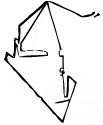Tuesday, May 8, 2012
A personal assignment. 'Chinese Bondage in Peru', by Wintergarten Ltd
A butterfly rests on a flower, two soldiers walk out of a thick smoke wearing gas masks, a pair of legs stands next to a table with a bottle of wine and some other indefinite objects. Short paragraphs appear in between the images, they sound like excerpts from a science report, some make sense but sound out of context, others are more extended but their meaning remains obscure despite their academic style, like cryptic meter-less poetry.
Chinese Bondage in Peru is a set of three small artists' books by Wintergarten Ltd, an art collective from Los Angeles. It features a collection of found photographs, printed matter and accompanying text revolving around the vague fictitious narrative of a North American journalist's travels between the the continents of Latin America and Asia, and its title is taken from an academic publication about the exploitation of Chinese migrant laborers in Peruvian guano pits by 19th century colonists. Like a documentary turned upside down, the more you flip through the pages of the books, the more any narrative or logic reference is progressively lost, as if the goal was exactly to subvert the illusionary self-evidence of the title and of the semantics of the texts, where although every word is clear, their common meaning remains elusive.
The same happens with the images, which at times seem to create short narrative segments, only to be controverted by the photographs in the following pages. What is surprising is the fact that, despite all this, the images stand beautifully together throughout the three volumes, as if immersed in the same music: that is obtained in different ways, like the newspaper chosen to print the set, the surface of which flattens the technical differences among the various photographs, giving them a beautiful monochrome opacity. The different photographic styles and subjects this way become like a collection of finds and leads, gathered to give the viewer a chance to discover what links one to the other.
Evidence by Mike Mandel and Larry Sultan was another book (perhaps ‘the’ book) collecting found photographs of obscure meaning. In that case the images shared the fact that they were showing unspecified activities relating to the public sphere, whether it was from corporate, scientific or government sources. Chinese Bondage in Peru could be considered like a sentimental version of Mandel & Sultan's book, where the source material is shaped in a personal diary, with both public events and private memories appearing and merging into each other, like the scattered recollections of a man suffering of amnesia, whose memory works in fits and starts, struggling to find the story behind all those flashes of images haunting his mind.
Una farfalla riposa su un fiore, due soldati con maschere antigas emergono da un fumo denso, due gambe accavallate stanno accanto a un tavolino con sopra una bottiglia di vino e altri oggetti indefiniti. Tra le immagini compaiono brevi paragrafi, sembrano passaggi di un qualche testo scientifico, alcuni dal senso piuttosto chiaro ma estrapolati arbitrariamente, altri più estesi ma incomprensibili nonostante il taglio fortemente accademico dello stile, oscure poesie prive di metrica.
Chinese Bondage in Peru è una pubblicazione in tre volumetti creata dal collettivo Wintergarten Ltd di Los Angeles: una collezione di fotografie anonime che segue le orme dei viaggi di un immaginario giornalista americano tra America Latina e Asia, seguendo la suggestione del titolo, preso in prestito da un saggio sullo sfruttamento della manodopera cinese nelle fosse di guano in Peru nel XIX secolo. Come un documentario capovolto, più si sfogliano le pagine dei tre fascicoli e più si perde ogni forma di coerenza logica e narrativa, come se l’intento fosse proprio di smentire la chiarezza espositiva del titolo e della semantica dei testi, dove spesso si comprende ogni parola ma non si è in grado di legarle in un significato comune.
Lo stesso accade con le immagini, che dànno l’illusione di creare piccoli segmenti narrativi, ma che vengono poi progressivamente smentiti dalle fotografie che incontriamo nelle pagine successive. Quello che stupisce è che, nonostante tutto, il percorso che si crea tra i tre capitoli del progetto sviluppa comunque una sua forma di coerenza, un rumore di fondo che accompagna la visione di tutte le immagini: a partire dalla carta di giornale con cui il piccolo set è stato realizzato, la cui superficie fibrosa livella le differenze tecniche tra le fotografie immergendole in un’opaca monocromia che crea una patina di ricordo, come se davvero quei volumetti fossero il tentativo di ricostruire qualcosa che è accaduto, una cronaca impossibile; i diversi stili e soggetti fotografici diventano come varie forme di indizi e reperti, raccolti per dare all’osservatore la possibilità di scoprire la trama che li unisce.
Anche Evidence di Larry Sultan e Mike Mandel mostrava una serie di fotografie anonime di difficile se non impossibile interpretazione, immagini che però avevano in comune il mostrare imprecisate attività afferenti a una sfera pubblica, corporativa o scientifica che fosse, e tutte venate da una cripticità che dava loro il giusto tocco cospiratorio. Chinese Bondage in Peru potrebbe essere considerato una sorta di versione sentimentale del libro di Sultan e Mandel, dove il materiale di partenza è stato trasformato in una specie di diario personale, dove eventi pubblici e memorie private si alternano e si trasformano gli uni nelle altre, come la ricostruzione stentata di una vittima di amnesia, la cui memoria funzioni a macchie, riattivandosi per brevi istanti in forma di immagini di cui non riesce a ricordare la storia.
CHINESE BONDAGE IN PERU, Volumes I, II & III, by Wintergarten Ltd. Softcover, 5.5 x 8.5". Black & white laserjet on newsprint, 2012.
Subscribe to:
Post Comments (Atom)








No comments:
Post a Comment